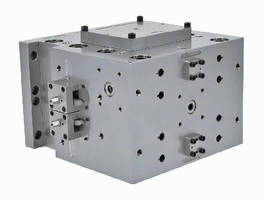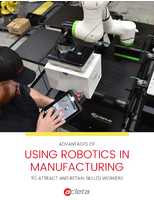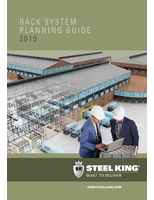Coextrusion Feedblock fine-tunes individual layers.
Press Release Summary:

With EDI™ Ultraflow™ V-T Feedblock, processors of film, sheet, and coatings can fine-tune individual layers as well as accommodate changes in layer ratio, and adjust tuning system without removing feedblock from production line. Flow channel widths range from 2–7 in., depending on width of product to be extruded. Larger volume feedblock channels reduce shear stress and interfacial instability. With 100 in. die, spreading ratio is 25:1 for 4 in. feedblock channel, but only 14:1 for 7 in. channel.
Original Press Release:
New Feedblock Fine-Tunes Each Layer and Balances Velocities of Combining Melt Streams, Yielding Stable Coextruded Structures
EDI™ Ultraflow™ V-T Feedblock from Nordson Is Adjustable On-Line and Is Available with Larger than Usual Channel Widths to Reduce Shear Stress and Interfacial Instability
CHIPPEWA FALLS, WI, U.S.A., -- A new-generation coextrusion feedblock from Nordson Corporation enables processors of film, sheet, and coatings to fine-tune individual layers as well as accommodate changes in layer ratio, and to adjust the tuning system without removing the feedblock from the production line. Nordson will introduce the patent-pending technology at K 2016 (Hall 2, Stand G06), along with the availability of feedblocks with wider than standard flow channels that reduce shear stress and enhance end-product quality and consistency.
A feedblock combines melt streams from separate extruders into a multi-layer “sandwich” that the extrusion die subsequently distributes to target product width. The new EDI™ Ultraflow™ V-T feedblock has separate devices for fine-tuning layer stability and thickness uniformity, and both are capable of being adjusted without stopping production. As in the widely used Ultraflow™ V feedblock, one of these devices is a pair of “combining planes” (located where the outer-layer melt streams join the core layer in the central flow channel) that fine-tune the overall structure by adjusting the gaps at the point of layer combination. What is new is a pair of “profiling actuators” (located opposite the combining planes) within which are mounted interchangeable “profile bars” that fine-tune the thickness uniformity of the individual layers (see schematic). For coextrusion of more than three layers, additional tuning devices are placed farther downstream, where more melt streams join the central structure.
“Because the profiling actuators are large in diameter, they accommodate wider profile bars and enable them to be positioned either close to or farther from the layer combining point,” said Sam G. Iuliano, business development manager for polymer dies. “This provides more area for tuning layer thickness uniformity and thus makes possible more accurate and effective tuning. In addition, changing the position of the profile bars dramatically changes the result, allowing for significant process refinements to be made on-the-fly.”
The positioning of the profile bars with respect to the combining point is adjusted by rotating the profiling actuators. This is accomplished by turning nuts on the outside of the feedblock in accordance with a position indicator and does not entail stopping production.
The profile bars are available with various surface configurations, including a standard bar with a uniform raised surface and others designed to correct such issues as heavy end flow, heavy center flow, or “M” or “W” patterns. The bars are installed in dovetail grooves in the surface of the profiling actuators. A cover plate in the feedblock provides access for replacing one set of bars with another.
“Adjusting the profiling actuators in the Ultraflow V-T feedblock makes it possible to influence the distribution of a particular layer,” said Mr. Iuliano. “If further adjustment is necessary, one can replace the profile bars by briefly stopping production, without having to remove the feedblock from the extrusion line.”
Nordson will specify a feedblock whose flow channel differs in size from the standard 4 in. (100 mm), with widths available from 2 in. (50 mm) up to 7 in. (180 mm) depending on the width of the product to be extruded. Larger volume feedblock channels reduce the shear stress levels at the layer interfaces and a wider feedblock channel contributes to a more consistently on-specification product. In the case of a 100-in. (2,540-mm) die, for example, the spreading ratio is 25:1 for a 4-in. feedblock channel but only about 14:1 for a 7-in. channel.
New EDI™ Ultraflow™ V-T Feedblock Retain Benefits of Current Adjustable System
“As in the Ultraflow V feedblock, the combining planes in the new Ultraflow V-T system combine polymers in a parallel-path manner, achieving optimal layer ratio stability throughout the structure,” said Mr. Iuliano. “Their ability to be adjusted ‘on the fly’ increases uptime and allows for greater end-product versatility.”
The Ultraflow V-T feedblock is available with Nordson’s optional selector spool that allows the layer sequence to be pre-arranged upstream of the combining point, without removing the feedblock from the production line.
Schematic Caption: Schematic of internal working components of EDI™ Ultraflow™ V-T feedblock shows fine-tuning of a three-layer coextrusion. Flow direction is from left to right. First, two tear-drop shaped “combining planes” tune the overall structure by adjusting the gaps at the point of layer combination, where the outer-layer melt streams (blue and gold) join the core layer (red) in the central flow channel. At the same time, two cylinder-shaped “profiling actuators” (located opposite the combining planes) tune the thickness uniformity of the individual layers by means of interchangeable “profile bars” (brown components mounted on the profiling actuators. For coextrusion of more than three layers, additional tuning devices are placed farther downstream, where more melt streams join the central structure.
Nordson Corporation engineers, manufactures and markets differentiated products and systems used for the precision dispensing of adhesives, coatings, sealants, biomaterials, polymers, plastics and other materials, fluid management, test and inspection, UV curing and plasma surface treatment, all supported by application expertise and direct global sales and service. Nordson serves a wide variety of consumer non-durable, durable and technology end markets including packaging, nonwovens, electronics, medical, appliances, energy, transportation, construction, and general product assembly and finishing. Founded in 1954 and headquartered in Westlake, Ohio, the company has operations and support offices in more than 30 countries. Visit Nordson on the web at http://www.nordson.com, @Nordson Corp, or www.facebook.com/nordson.
Nordson Polymer Processing Systems provides customers with engineered components to melt, homogenize, filter, meter, and give shape to plastic and fluid coating materials. Nordson Corporation leverages the collective plastics industry experience from a series of strategic acquisitions to offer a uniquely broad portfolio of industry-leading technologies. Nordson delivers a full range of precision melt stream products — from screws and barrels for extrusion and injection molding — to filtration systems, pumps, and valves — to the extrusion dies and pelletizing systems to meet the constantly evolving needs of the polymer industry.
Nordson Corporation provides customers with local technical sales, service and remanufacturing capabilities through sales organizations and regional manufacturing facilities in over 30 countries. To learn more visit us at www.nordsonpolymerprocessing.com or www.facebook.com/NordsonPPS.




